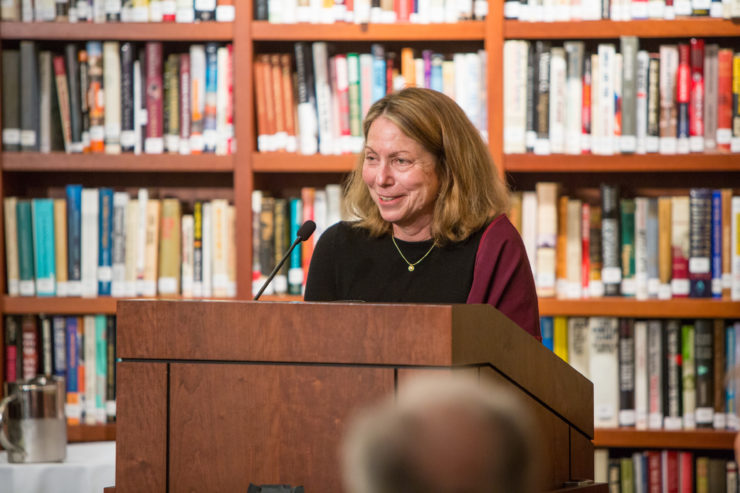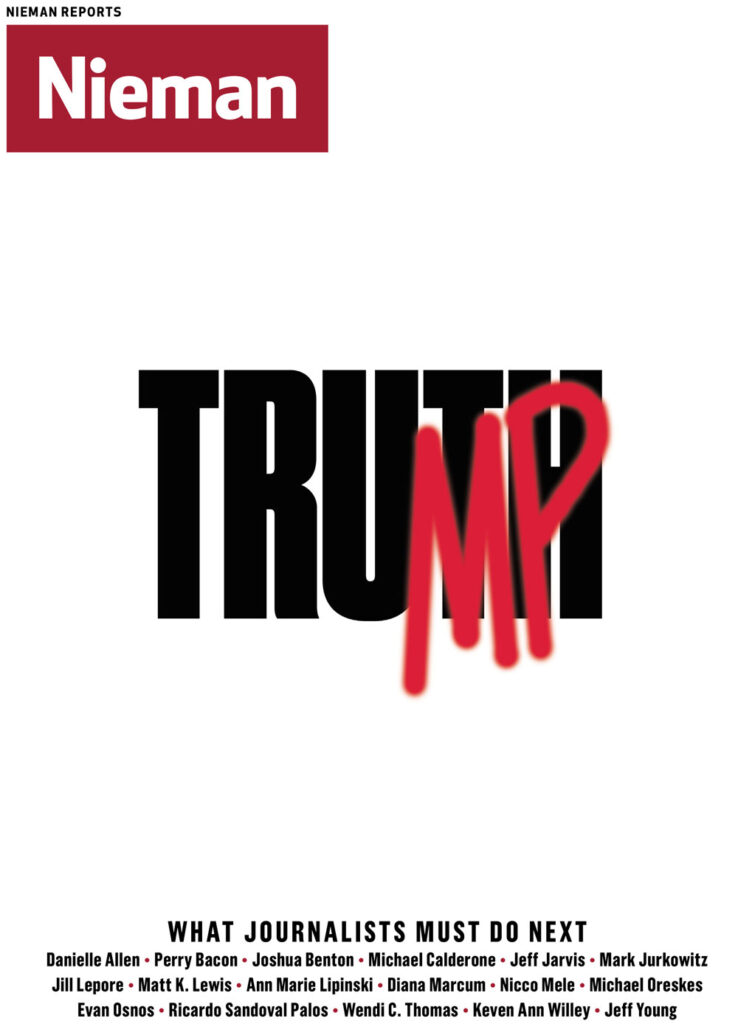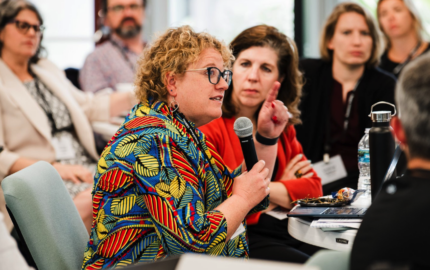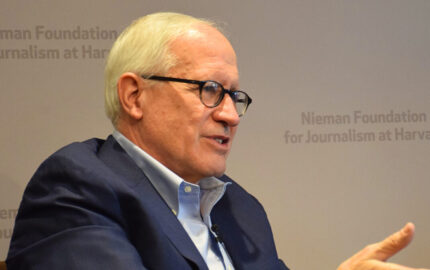Jill Abramson, executive editor of The New York Times from 2011 to 2014, worked at the Times for 17 years. Now she is writing a political column for The Guardian; teaching journalism at Harvard, which is her alma mater; and researching a narrative nonfiction book about the media. Modeled on David Halberstam’s “The Powers That Be,” her book will look closely at the evolution of BuzzFeed, Vice, The Washington Post, and The New York Times over the past 10 years. During a talk in September at the Nieman Foundation, she said that the two online media outlets and their legacy counterparts are “sort of switching hats.” The upstarts want the gravitas of the established print giants who, in turn, want to be “digitally innovative” and attract the young readers the upstarts have claimed as their own. Edited excerpts:
On sexism in the media
It surprises me that there are still so many stories that I would see at the Times that, if it was about a woman at the top of business, would always describe her clothes, especially shoes. There’s an obsession with shoes and heels that go, “Click, click, click.”
It’s not like I feel there should be strict rules, and you should never be able to describe someone, whether a man or a woman, or anybody’s clothes. Sometimes it’s revealing, and important to talk about it, but you have to demonstrate in your writing why you’re bringing it up, why it’s emblematic and important. That’s rarely done.
I’m surprised that so many stories are still written that seem so stereotypical when women are the subjects, and that editors don’t immediately edit it out. There were too many regrettable times at The New York Times when something went into print, and then you would get an avalanche of reader revulsion.
Because I was the first woman in a lot of the most senior jobs I had at the Times, I felt personally ashamed, always, because I couldn’t possibly read everything that was going into the paper.
I thought it was a very cool achievement that the news masthead of the Times became 50 percent female during my first year as executive editor, but I don’t think that generated much support. Don’t expect a round of applause from your people, because it became synonymous with “Jill is playing favorites.” I’m not saying other parts of my leadership were flawless, by any means, but I thought that was a much bigger deal than most of my colleagues did.
On the importance of diversity
There’s not enough diversity in most newsrooms. That’s something I admire about BuzzFeed. Their newsroom is very diverse. They have succeeded. It can be done. You have to have leadership at the top who really cares about it.
If you have a diverse business, you get more customers. If you use diverse suppliers, you have a stronger business. It directly impacts the audience, because it means that, with stories affecting women, you won’t have so many that talk about, dwell on, appearance. You won’t be slow to realize that the Trayvon Martin case is a national story. The national news media was slow on that story. At least having been in The New York Times newsroom then, there weren’t enough journalists—either editors or reporters—saying “This is a huge story. Wake up. Wake up, you mainly white editors.” We’re supposed to be reflecting the world.
If you’re going to bring people the world, you better include people who are covering the world who have different perspectives and knowledge sets about the world. Your audience is not going to be diverse either, if you’re only telling things from the point of view of a very privileged, cosmopolitan white person.
On the book she’s writing
What I’m trying to do, which may be unattainable, is to write a version for now of “The Powers That Be,” which was, I thought, a great book that David Halberstam, a Harvard man and a Timesman, wrote about the media in the late ’70s. What he did is he focused on four institutions. It was The Washington Post, the LA Times, CBS News, and Time magazine. He made a narrative out of his theme, which was—it’s laughable now, but it’s that the media had become so powerful and so profitable that they towered over the political class, that they had too much concentrated power. What’s ironic, and I have great fears for my own book, is as he was writing this, it was becoming untrue, slowly, but if you graphed the highs and lows, it was starting to go down. What I’m trying to do in the time frame that I picked— from 2006 to now—is chart the transition from a print world to a digital world.
What I’m trying to do is write a version for now of David Halberstam’s “The Powers That Be”
I’m mimicking Halberstam. I’m looking at four institutions, and how they weathered those times. Why 2006? Because the iPhone was about to be introduced, Google bought YouTube, so video was really starting to become a big news conveyor. Twitter started in 2006. The Facebook news feed began in 2006. It’s a totemic year. It’s when BuzzFeed started, and it’s when Vice, which is another institution that I’m looking at closely, was becoming the cool brand. They were very early video pioneers. They used YouTube as their distribution system. In a way, BuzzFeed and YouTube were the first distributed content purveyors. They used that model. It didn't matter to them whether you came to vice.com or buzzfeed.com. They were using social media or YouTube. In addition to BuzzFeed and YouTube, I am looking at the Post and the Times.
The thing that interests me most is that what BuzzFeed and Vice are both doing now is building up more conventional news muscles. They badly want to create themselves as lasting institutions and get the respect that so-called legacy news organizations like The New York Times or The Washington Post get. The Washington Post and The New York Times are trying to become digitally innovative, so they’re sort of switching hats, and that interests me a lot. I’m interested in quality information surviving and growing. I haven’t yet reached a definitive conclusion, at least one that I’m ready to share.
On the shift in publishing
In the old days, which are really fairly recent, when something went up on the web or rolled off of the presses, that was publishing. That was the end. It was a finite point.
With the rise of social media, raising the awareness of the work is part of the actual publishing system now. That you have to get it out. That you have to know how to use Facebook or Twitter. BuzzFeed has many platforms that they distribute on. They custom design every article. Even for Pinterest.
It’s like, ‘We’re the Times and the Post, and we’ve published these stories.” Actually distributing them is not the job of trucks anymore. It’s the job of the journalist to distribute and call attention to the content of their stories.
The Post and the Times want a larger young readership. They should. God forbid either one of them dies out when their average reader is about 46 years old on the web and in print it’s a little bit older. When those people perish, the kind of journalism that the Times and The Washington Post uniquely do, you don’t want that to go away. You’ve got to get a younger generation in the habit of reading that highest-quality journalism.
On the appeal of BuzzFeed and Vice
BuzzFeed and Vice are in tune with younger news consumers. BuzzFeed’s legal editor, Chris Geidner, who is based in Washington, started covering the issue of gay marriage way earlier than many national news organizations. He knows the gay community inside and out so he was just on it. He knew this is a really big deal in the gay community, “Someone should have it as a beat, and that’s going to be me.” That was very early on. Vice’s pieces for HBO are like mini-documentaries. They go and cover places that no one else goes to.
On the low public trust in journalists
“Why?” is hard. It requires a many-faceted answer. A big reason for it is the dumbing down of news, turning everything—even a presidential debate—into a celebrity, as my students said, cage match. People feel that there’s no elevating or relevant purpose to investing your time in reading the news, because so little of it helps you figure out how to spend your day. What is really important? What isn’t important? It’s sort of a confusing jumble right now.
I love Eli Pariser’s book “The Filter Bubble.” At least in the U.S., there is a filter bubble and the way information spreads on social media and through algorithms means that you’re basically getting news that you agree with. That’s contributed to the polarization of news. Most people are not all that partisan so they’re not that interested in highly polarized news. They don’t really believe it when different outlets say they are not partisan.
On the demise of Gawker
I’m sorry it’s gone. I would look at it a lot. I’m not above reading gossip and I thought that [founder] Nick Denton in many ways was absolutely right in premising his theory of publishing on: if journalists are going to be talking amongst themselves about something really juicy, share it. Publish it.
I obviously have problems with publishing things that are untrue. I don't think everything they published should have been published, but I like that spirit. I like juiciness in news. I do.




